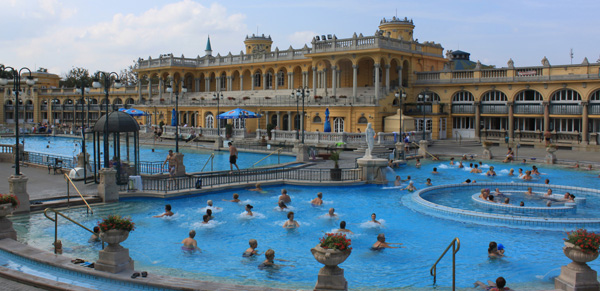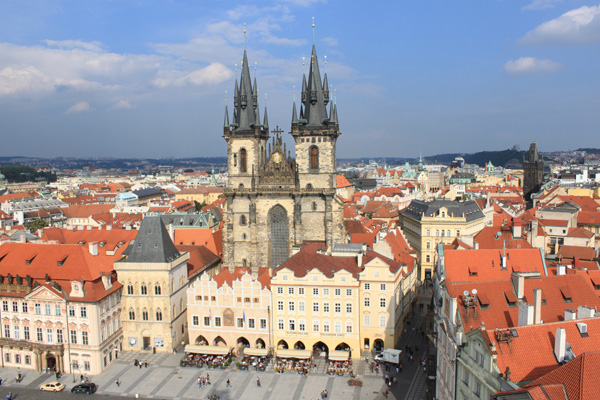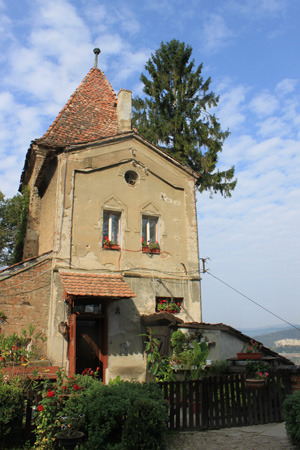BUDAPEST, HUNGARY – To my right sat an elderly man in a Speedo; eyes closed and head tilted contentedly back. To my left was a smiling woman of the same age, blissfully spilling out of her bathing suit. I slipped into the pool a bit timidly and into a deep-rooted part of the Hungarian people’s lifestyle: the thermal baths.
Natural hot springs steam throughout the country but Budapest has more than almost anywhere else in the world. Széchenyi was the first thermal bath in Pest, the eastern side of the city, and is now one of the largest spa complexes in Europe.

Above: Széchenyi was the first thermal bath in the city of Pest.
My whirlwind train journey through central Europe started in Amsterdam, though, a convenient gateway for Canadians. After seeing the Rijksmuseum, Van Gogh Museum, Anne Frank House; taking a stroll through the Red Light District and hopping on a canal cruise, Amsterdam becomes a city best experienced without a plan.
I based my two days around the Ambassade Hotel, made up of 10 canal-side houses from the 17th century. Here, I came upon a newly created area called “The 9 Streets.” Spread over, you guessed it, nine small side streets, are fascinating independent boutiques and cafés. Take the De Witte Tanden Winkel store for instance. This location opened in 1979, selling only oral hygiene products.
I pulled myself away from the funky shops and made it to Centraal Station in time to catch my train to Berlin. I watched from my comfortable cabin as fields of green farmland changed hands from Holland to Germany.
Once in Berlin, it was impossible to compare it to postcard-ready Amsterdam; instead of canals around every corner there is gritty graffiti; instead of those quintessential canal-side houses there are restored (or not) cement communist-era buildings. But Berlin knows it doesn’t have to rely on good looks to be popular. Instead, it charms visitors with its playground of creativity and buzz-worthy arts scene.


Above: Prague, left and small town in Romania, right, also thrill travellers.
I hopped on one of those tourist buses, Berlin City Tour so I could hit most of the major sites in one day: Brandenburg Gate, Checkpoint Charlie, Bebelplatz (of Nazi book burning fame), the Holocaust Memorial and the Topography of Terror, which is where a remainder of the original Berlin Wall stands.
Berlin is monumental in every way, with so much going on beneath the skin of the streets at all hours of the day and night. I’ve never left a city that I was so fascinated by, but leave I must - onward to the Czech Republic, where the scenery out the train window went from grey buildings to cliffs swarmed by trees.
The beauty crept up on me as I glided deeper into the country, cumulating in Prague, a city that looks so unlike Berlin I wondered if I was on the same continent. With so many exquisite buildings, I’m sure they were built in a jumble so they could all be fit in. While Berlin was a bombing ground during World War II, Prague was left almost untouched.
I spent two days wandering through the compact city with the help of the travel company IncoCzech, climbing to the top of all the tower lookouts and getting tangled in the web of one-block streets with long names; I took a dinner cruise to see the city at night and walked up the hill to the 70,000 m² Prague Castle.
When my mind finally short-circuited from architectural overload, I was back on the train heading south to Vienna. From the compact streets of Prague, the expansive capital of Austria was like a gigantic breath. Wide boulevards lined with elegant opera houses and grand museums, most built between 1860 and 1910, were balanced with green space around every corner.
From the trendy Hotel Das Tyrol beside Museum Quarter, I popped in and out of art galleries, museums and exhibition spaces. Probably the most Viennese of all were the historic coffee houses – stocked with heavenly sweets, where the collection of newspapers is far more important than the coffee itself. This is the kind of city you want to pack your bags and move to.
Instead, I packed my bags and headed for Hungary. After a short train ride through the countryside, I made my first stop in Sopron. This small industrial city is a short drive from where the 1989 Pan-European Picnic took place, bringing the Iron Curtain down and letting East Germans cross over to the west.
Then it was onto Budapest, where I steamed in the thermal baths of Széchenyi and watched Puccini’s Tosca at the glorious Hungarian State Opera. I now understand why people are so crazy about this underrated city.
Also overlooked is neighbouring Romania. I decided to spend the night in Sighisoara at the Fronius Residence, tempted by the luxury rooms in a house that dates back to 1609. I was not disappointed. Not only was the hotel outstanding but the town was gorgeously restored from medieval times, complete with Vlad Dracula’s house.
As I sat on the train to Bucharest, a chaotic city with some neat (but spread out) corners, I wished I had taken the time to stop at some of the towns en route – Alba lulia, Sibiu, Brasov – all restored and without the frenetic pace of the capital. Bucharest is an interesting city, though, developing a coolness factor in the historic centre with trendy bars and chic hotels. I stayed in one, the Rembrandt Hotel, a stylish boutique accommodation that is Dutch-owned, bringing back memories of Amsterdam that seemed a lifetime ago.